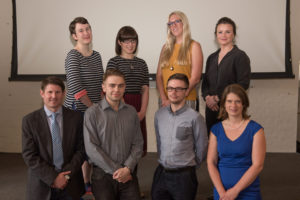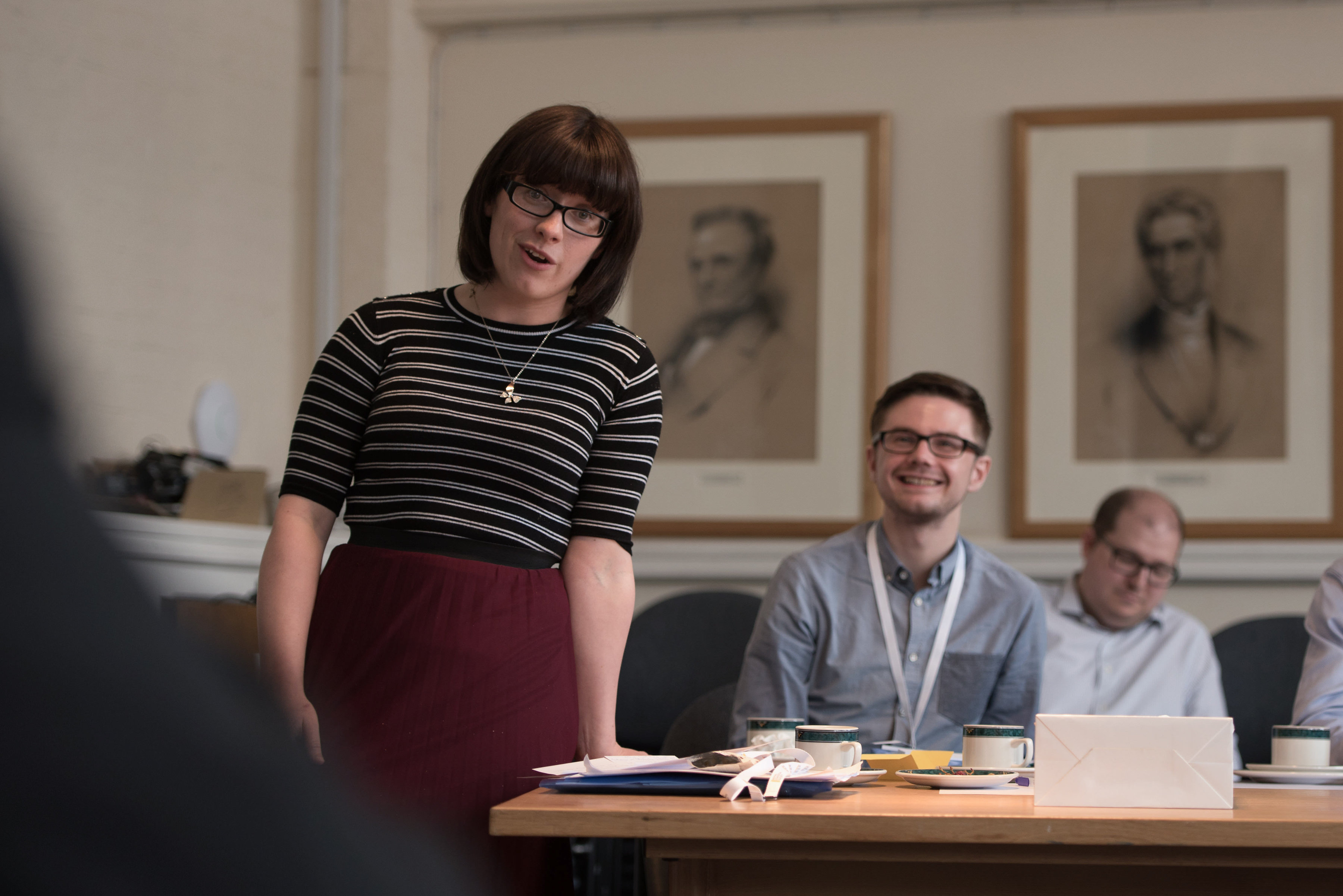Being a SAMBa student often leads to unusual and interesting opportunities that you might not find (or be pushed towards!) elsewhere. An email went around the department back in March advertising the RSS Statistical Ambassador Programme and encouraging anyone interested to consider applying. Being an incredibly new postgrad, I didn’t take it seriously at the time, but a chance meeting with Jo Jordan (from the Bath IMI) and my supervisor, Dan Simpson, made me reconsider. After all, this was the perfect opportunity for an outspoken Irish girl like myself to continue her schemes towards world domination… My general love of maths outreach was clearly only a tiny factor!
 2016 cohort of RSS Ambassadors (Elyse Marks Imaging/RSS)
2016 cohort of RSS Ambassadors (Elyse Marks Imaging/RSS)
Of course, work and illness took their toll, and I just about managed to put an application together before the deadline. The combination of that being such a rush-job in the end, along with my certainty that there were bound to be countless more experienced, qualified candidates made me sure that I didn’t have a chance. I promptly forgot all about it until, a few weeks later, I got an email from Scott Keir, Head of Education and Statistical Literacy in the RSS, congratulating me on my successful application and inviting me to a training day in London in May along with my fellow new ambassadors. I managed to not fall over entirely with shock, but being me that was a pretty close call!
To explain my excitement, the RSS statistical ambassadors programme is a pilot scheme set up to help develop the public communication skills of a selected cohort of UK-based professional statisticians. It aims to support those wishing to engage with public audiences about statistical matters through the media (TV, radio or in print), in person, or online – and encourages participation in RSS media requests. It is aimed towards early-career statisticians, and provides training and mentoring sessions on communicating statistical ideas, media work, etc. with experts in communication such as David Spiegelhalter, Winton Professor for the Public Understanding of Risk at Cambridge University and RSS President-Elect. Spiegelhalter is one of my idols, so you can imagine just how excited I was about this.
Trains to London are horrifically expensive at peak times so, not wanting to expense the RSS up to the eyeballs, I took a very painful 4am National Express coach to London Victoria. A tube to Liverpool St, breakfast and some much-required coffee later, and I still arrived about 45 minutes too early! Just as well, as it probably took me that long to explain just why my name is so awkward..
The day kicked off around 9:30, with some fun (and competitive!) icebreakers. Thankfully, as anyone who knows me will agree, I like to talk and finding common ground with new people is something I find pleasant and easy. It was a quick way to find out that I wasn’t the only rugby player, wannabe trapeze artist and obsessive coffee drinker. We continued into some group work sessions, discussing how to communicate complex statistical ideas, eventually turning them into one-minute soundbites that grabbed the group’s attention. I was lucky to have the Birthday Paradox, which is confusing but at least you can make use of your audience! I wasn’t so lucky in the afternoon, unfortunately, as you’ll see later. In the morning session, we were fortunate to have the insight and feedback of David Spiegelhalter for our soundbites and general discussion. Hearing his stories of public engagement – positive and negative – was incredibly eye-opening and gave me plenty of food for thought for future ideas. They say you should never meet your idols, but I have a 1/1 success rate here!
Lunch involved one of my favourite things – lunch - and one of my least favourite - being photographed. The latter experience was made less terrifying by the wonderful Elyse Marks, a professional photographer who did the best she could with me! After several excellent conversations over lunch (Goats With Coats being a highlight - an idea for a Monty Hall problem-themed bus busking sketch), we launched straight into the afternoon’s presentation skills workshop with Timandra Harkness (a writer, presenter and comedian who focuses her work on statistics). We started out with drawing a statistical concept out of a bag at random… and had to act out whatever we told. Silently. Yes, I do mean Statistical Concept Charades. This was all entirely hilarious until it came to my turn. To my horror, I drew causation and correlation. How is it even possible to act that out?! I struggled valiantly, and several minutes and dramatic falls later, someone finally put me out of my misery and guessed correctly. Phew! It certainly made me realise the value of non-verbal communication though…
 Acting the part of a sheriff to explain prosecutor's fallacy (Elyse Marks Imaging/RSS)
Acting the part of a sheriff to explain prosecutor's fallacy (Elyse Marks Imaging/RSS)
We moved onto story-telling, and how to draw a crowd in. Timandra taught us a range of really useful tricks to compel an audience, and I’ll certainly make use of those in future outreach events. We finished up working in pairs on a statistics-themed sketch. Myself and my sketch partner were asked to explain prosecutor’s fallacy to the audience… with a Western theme. I obviously jumped at the chance to practice my range of accents, and played the part of the drawling idiot sheriff to perfection (definitely). Each of the group sketches were entirely hilarious, yet each team managed to get the theme across incredibly clearly. You could really see the progress we’d all made in a day! We wrapped up with some well-earned drinks and a promise to keep in contact – which I will certainly be doing with this fascinating, engaging group of people!
We’ve had a few opportunities to respond to media requests since (I can’t even begin to explain how strange they can be), and have upcoming media training and specialist training to look forward to. Even with just the one day’s training behind me, I can say I’m incredibly lucky to have this opportunity and it’s really made me consider the varied ways I can make my research interesting and relevant to the public. One of the questions I asked at my SAMBa interview way back in February 2015 was whether the CDT had much involvement in outreach. If I have my way, that will be a very easy question to answer in the future.
Respond


